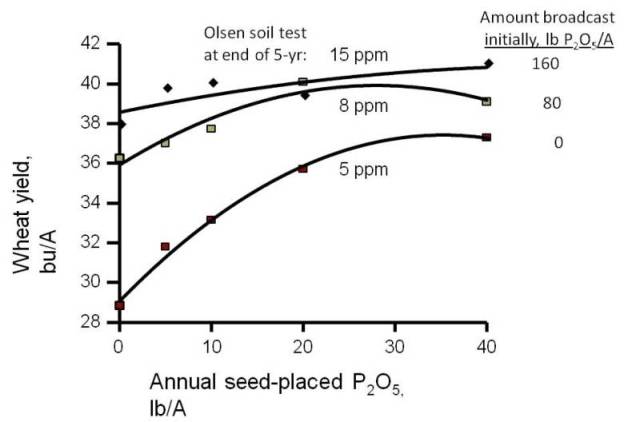Which Supply of Phosphorus is more Critical to Producing High Yields: Fertile Soil or Applied Fertilizer?
Prepared by John Heard, MB Ag Soil Fertility Specialist
I posed this question to several seed agronomists at a recent meeting and perhaps to the chagrin of the fertilizer industry – they identified fertile soils as being more important. The practical answer would be expected to be a combination of the two.
Many of our phosphorus (P) fertilizer recommendations are based on a sufficiency approach, which are rates that give the most economic response for that crop, with little regard to building or maintaining soil test levels. One of the premises of the sufficiency approach is that these fertilizer applications are adequate to produce near maximum yields even when soil test levels are low. But there is a scarcity of studies where soils of different fertility levels exist within the same site. Following are observations from a few of these existing studies on hard red spring wheat, corn and soybeans and their yield response to fertile soil and applied fertilizers.
Wheat
The graph attached in Figure 1 shows the results of phosphorus fertilization on wheat near Saskatoon (Wager et al, 1986). Different soil P levels were achieved at the start of the study by applying batch applications of phosphorus, followed by annual seed-placed P rates.

Over the 5 years of the study the highest yields were achieved where a medium-high soil P level (15 ppm) was achieved with the initial high broadcast application. Annual application of seed-placed P increased yield slightly on the higher testing soil. In contrast the wheat grown on the very low (5 ppm P) and low (8 ppm P) testing soils responded strongly to annual P applications. However, even with this strong yield response to annual P applications, the yields were not maximized. In fact on the very low testing soil, maximum yields were 4-5 bu/ac less than on the soils testing 15 ppm.
Wheat yields of 40 bu/ac typically remove between 21-26 lb P2O5/ac, so this amount would need to be replenished to maintain the soil test levels in these ranges. Any building of lower testing soils would require phosphorus applications greater than removal amounts.
Corn and Soybeans
A recent 3-year study in Minnesota evaluated crop yield response to phosphate fertilizer at a site with both low and high soil P levels (reported by Leikam et al, 2010). The low P soil resulted from mining P through 10 years of grain, silage corn and soybean production without phosphate fertilizer. Phosphorus was applied to the corn in a number of placement options at 2 rates, followed by an unfertilized soybean crop dependent on that residual P (Table 1).
Table 1. Corn and soybean yield response to applied phosphorus on low and high P soils (Source: Gyles Randall, University of Minnesota).
Applied P Lb P2O5/ac* |
Corn yield bu/ac |
Soybean yield bu/ac | ||
|
Low P Soil (6-9 ppm Bray P***) |
High P Soil (20-27 ppm Bray P***) |
Low P Soil (6-9 ppm Bray P***) |
High P Soil (20-27 ppm Bray P***) |
0 |
148 |
193 |
34.5 |
49.1 |
25/20** |
161 |
195 |
35.9 |
49.4 |
50/40** |
168 |
190 |
38.7 |
48.9 |
* Rates are the mean of 4 P placement methods
** The higher rate was applied to the low P soil, the lower rate to the high P soil
*** Olsen P equivalent values for these soils would be approximately 4-7 ppm P and 15-20 ppm P.
On the high testing soil, neither corn nor soybean responded to P applications. However, such high corn and soybean yields would remove some 110 and 50 lb P2O5/ac, respectively, and require such applications to maintain these soil levels.
Crops on the low testing soil responded favourably to P fertilizer application as expected. But fertilizer phosphorus applications did not close the substantial yield gap for crops grown on low and high testing soils. Even the highest P rate left a gap of 22 bu/ac for corn and 10 bu/ac for soybeans.
In summary, it appears that soils with good phosphorus fertility status contribute relatively more to supporting high yields than in-season fertilizer application alone. However, these fertilizer applications are critical on low testing soils to narrow the yield gap. Growers recognizing this will over time strive to slowly build their low P soils to a medium-high range where maximum yields can be achieved. Even the relatively conservative sufficiency approach to P recommendations was established to afford some slow P building of low testing soils.
Growers must also consider the environmental consequences of phosphorus losses in surface water and impairment of water quality. Employing the International Plant Nutrition Institute’s 4Rs of Nutrient Stewardship (Right Rate, Right Place, Right Time and Right Source) and other soil management BMPs are critical to balancing agronomic productivity and the environment.
References
Wager, B.I., J.W.B. Stewart, and J.L. Henry. 1986. Comparison of single large broadcast and small annual seed-placed phosphorus treatments on yield and phosphorus and zinc contents of wheat on Chernozemic soils. Can J. Soil Sci. 66:237-248.
Leikam, D., G. Randall and A. Mallarino. 2010. Are current soil test-based phosphorus and potassium recommendations adequate? Crops & Soils. Vol.43-6. Pp 27-32.

